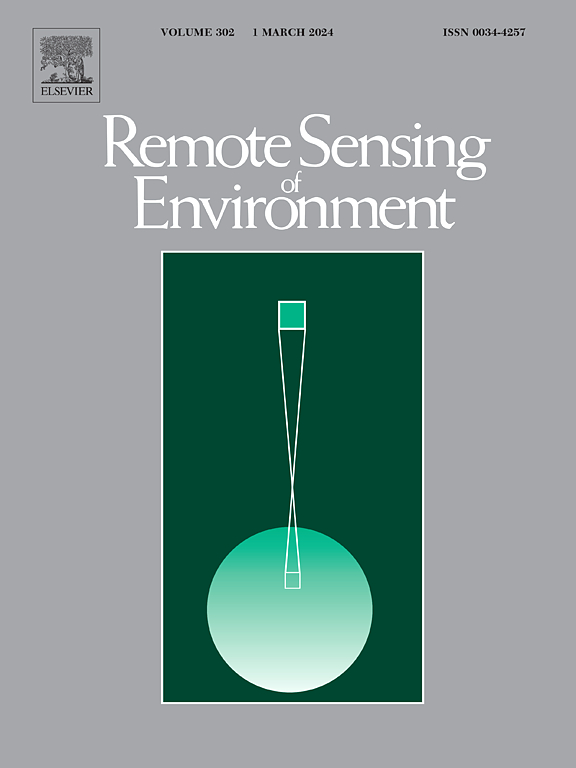基于静止与极轨卫星数据的遥感地表温度角效应校正
IF 11.4
1区 地球科学
Q1 ENVIRONMENTAL SCIENCES
引用次数: 0
摘要
卫星地表温度(LST)是一个方向性变量,具有显著的角度各向异性。这一特征增加了不同卫星衍生LST产品之间的差异,因此增加了使用多传感器和多年代际数据提供长期和角度一致的LST气候数据记录的挑战。核驱动模型能很好地平衡可解释性和可操作性,适合于LST产品的角度归一化。核驱动模型的定标依赖于多角度数据,由于地表温度的时空异质性,难以获得多角度数据。本文通过构建1颗地球静止卫星(GOES-R/ABI)和4颗极轨卫星(Terra/MODIS、Aqua/MODIS、Metop/AVHRR和S-NPP/VIIRS)的多角度地表温度数据集,提出了一种基于核驱动模型的地表温度角度归一化方法,对卫星衍生地表温度产品的角度效应进行校正。该数据集收集了更丰富的角度信息,即同一像素的三种不同观测几何形状的lst。利用2020年美国大陆(CONUS)的多角度LST数据集对核驱动模型进行了校准。9种土地覆盖类型四季地表温度角归一化前后均方根差的差异在0.14 ~ 1.10 K之间。将校正后的核驱动模型进一步扩展到其他年份和地区(即2021年的CONUS和2020年的东亚),得到了类似的结果。采用LST角归一化方法对MODIS LST产品的角效应进行校正。结果表明,地表温度差(角度归一化前后地表温度)的空间分布与观测天顶角(VZA)有很强的相关性。将2020年1月、4月、7月和10月近最低点观测的MODIS地表温度与Landsat 8和Sentinel-3 A地表温度进行了角归一化前后的比较。不同月份MODIS LST与Landsat 8 LST的均方根误差(RMSE)降低了0.94 ~ 2.06 K,不同土地覆盖类型的均方根误差降低了0.13 ~ 2.61 K。在不同月份,sentinel - 3a的RMSE降低了0.30 ~ 0.64 K。在六个SURFRAD站点进行现场测量,进一步验证了MODIS LST在角归一化前后的精度。VZA≥45°时,MODIS地表温度角归一化前后的RMSE与原位地表温度存在较大差异。在GWN站点,最大的差异高达约1.3 K。地表温度角度归一化方法具有提供角度一致的地表温度气候数据记录的潜力。本文章由计算机程序翻译,如有差异,请以英文原文为准。
Angular effect correction of remotely sensed land surface temperature by integrating geostationary and polar-orbiting satellite data
Satellite-derived land surface temperature (LST) is a directional variable and has significant angular anisotropy. This characteristic contributes to enhance the differences among different satellite-derived LST products, and therefore increases the challenge of using multi-sensor and multi-decadal data to provide a long-term and angle-consistent LST climate data record. The kernel-driven model can balance the interpretability and operability well, so that it is suitable for angular normalization of LST products. The calibration of the kernel-driven model depends on multi-angle data which is difficult to obtain due to the spatial-temporal heterogeneity of LST. In this study, a novel LST angular normalization method based on the kernel-driven model was proposed to correct the angular effect of satellite-derived LST product by constructing multi-angle LST dataset from one geostationary satellite (GOES-R/ABI) and four polar-orbiting satellites (Terra/MODIS, Aqua/MODIS, Metop/AVHRR, and S-NPP/VIIRS). The dataset gathered more abundant angle information, i.e., LSTs from three different observation geometries for the same pixel. The kernel-driven model was calibrated using the multi-angle LST dataset in the Continental United States (CONUS) during the year 2020. The discrepancies of the root mean square difference between LST before and after angular normalization range from 0.14 K to 1.10 K over nine land cover types in the four seasons. Similar results are obtained when the calibrated kernel-driven model was further expanded to other years and areas (i.e., the CONUS in 2021 and East Asia in 2020). The LST angular normalization method was applied to correct the angular effect of MODIS LST product. The results indicate that there is a strong correlation between the spatial distribution of LST differences (LST before and after angular normalization) and view zenith angle (VZA). MODIS LSTs before and after angular normalization were compared with Landsat 8 LST and Sentinel-3 A LST in near-nadir viewing for January, April, July, and October 2020. The angular normalization reduced the root mean square error (RMSE) between MODIS LST and Landsat 8 LST by 0.94–2.06 K in different months and by 0.13–2.61 K over various land cover types. For Sentinel-3 A, the RMSE decreased by 0.30–0.64 K in different months. The accuracies of MODIS LST before and after angular normalization were further validated using in situ measurements at the six SURFRAD sites. There are large discrepancies between the RMSE of MODIS LST before and after angular normalization versus in situ LST for VZA ≥ 45°. The largest discrepancy is up to approximately 1.3 K at the GWN site. The LST angular normalization method has the potential to provide an angle-consistent LST climate data record.
求助全文
通过发布文献求助,成功后即可免费获取论文全文。
去求助
来源期刊

Remote Sensing of Environment
环境科学-成像科学与照相技术
CiteScore
25.10
自引率
8.90%
发文量
455
审稿时长
53 days
期刊介绍:
Remote Sensing of Environment (RSE) serves the Earth observation community by disseminating results on the theory, science, applications, and technology that contribute to advancing the field of remote sensing. With a thoroughly interdisciplinary approach, RSE encompasses terrestrial, oceanic, and atmospheric sensing.
The journal emphasizes biophysical and quantitative approaches to remote sensing at local to global scales, covering a diverse range of applications and techniques.
RSE serves as a vital platform for the exchange of knowledge and advancements in the dynamic field of remote sensing.
 求助内容:
求助内容: 应助结果提醒方式:
应助结果提醒方式:


